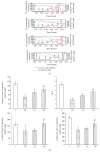The Protective Effects of Salidroside from Exhaustive Exercise-Induced Heart Injury by Enhancing the PGC-1 α -NRF1/NRF2 Pathway and Mitochondrial Respiratory Function in Rats
- PMID: 26167242
- PMCID: PMC4488012
- DOI: 10.1155/2015/876825
The Protective Effects of Salidroside from Exhaustive Exercise-Induced Heart Injury by Enhancing the PGC-1 α -NRF1/NRF2 Pathway and Mitochondrial Respiratory Function in Rats
Abstract
Objective: To test the hypothesis that salidroside (SAL) can protect heart from exhaustive exercise-induced injury by enhancing mitochondrial respiratory function and mitochondrial biogenesis key signaling pathway PGC-1α-NRF1/NRF2 in rats.
Methods: Male Sprague-Dawley rats were divided into 4 groups: sedentary (C), exhaustive exercise (EE), low-dose SAL (LS), and high-dose SAL (HS). After one-time exhaustive swimming exercise, we measured the changes in cardiomyocyte ultrastructure and cardiac marker enzymes and mitochondrial electron transport system (ETS) complexes activities in situ. We also measured mitochondrial biogenesis master regulator PGC-1α and its downstream transcription factors, NRF1 and NRF2, expression at gene and protein levels.
Results: Compared to C group, the EE group showed marked myocardium ultrastructure injury and decrease of mitochondrial respiratory function (P < 0.05) and protein levels of PGC-1α, NRF1, and NRF2 (P < 0.05) but a significant increase of PGC-1α, NRF1, and NRF2 genes levels (P < 0.05); compared to EE group, SAL ameliorated myocardium injury, increased mitochondrial respiratory function (P < 0.05), and elevated both gene and protein levels of PGC-1α, NRF-1, and NRF-2.
Conclusion: Salidroside can protect the heart from exhaustive exercise-induced injury. It might act by improving myocardial mitochondrial respiratory function by stimulating the expression of PGC-1α-NRF1/NRF2 pathway.
Figures





References
Publication types
MeSH terms
Substances
LinkOut - more resources
Full Text Sources
Other Literature Sources

